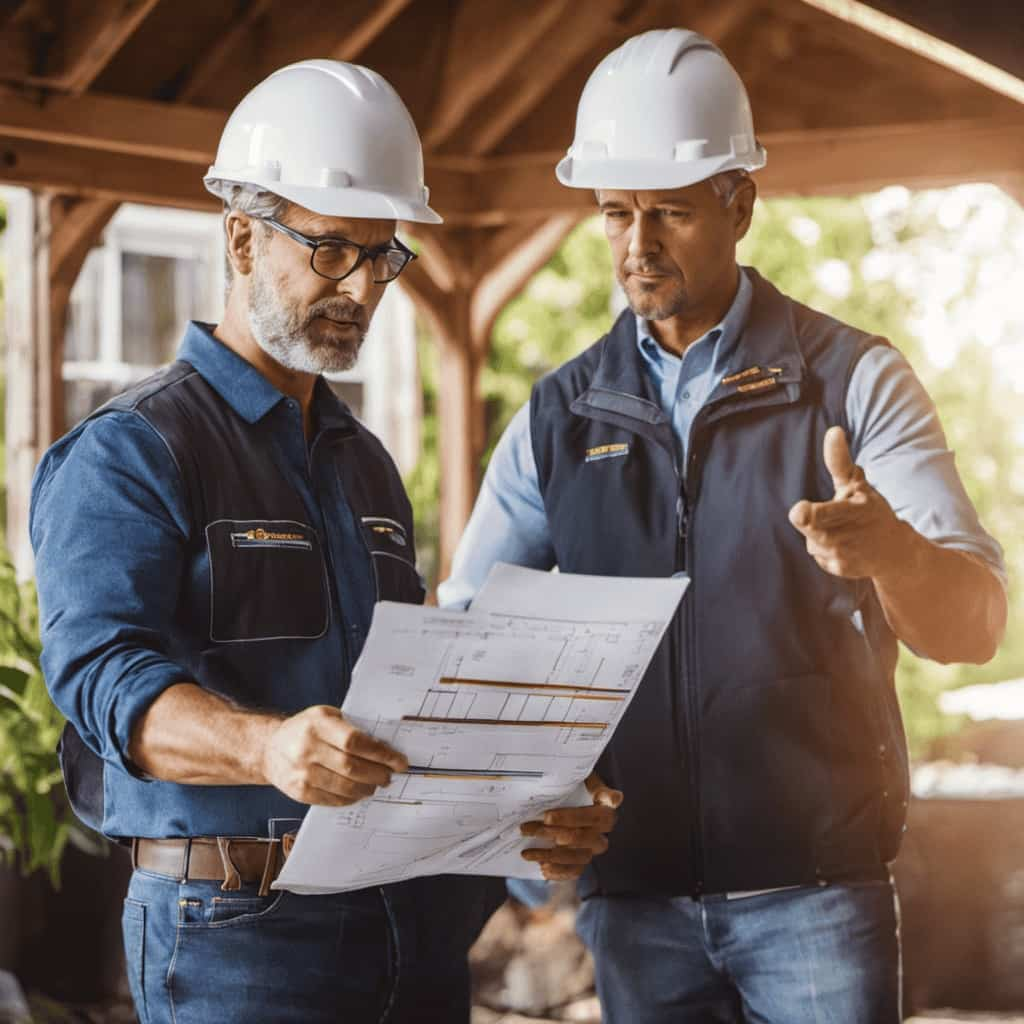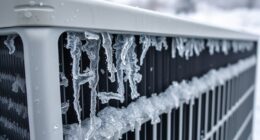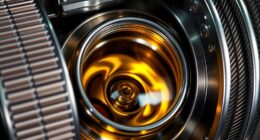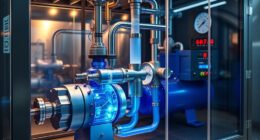We’ve got the necessary advice for maximizing the efficiency of your heat pump refrigeration system.
Regular maintenance is key to keeping your system running smoothly, so we’ll show you how to check for refrigerant leaks and clean the evaporator coil.
Plus, we’ll guide you through lubricating the compressor and preventing ice build-up.
Don’t forget about proper airflow and the role of the expansion valve.

Get ready to imprint these essential heat pump tips for optimal performance and efficiency.
Key Takeaways
- Regular maintenance is crucial for optimal performance and efficiency of the heat pump refrigeration cycle.
- Regular maintenance helps prevent costly repairs and saves both time and money in the long run.
- Regular maintenance improves energy efficiency and extends the lifespan of the heat pump.
- Proper insulation and airflow are essential for maximizing heat pump performance and efficiency.
Understanding the Heat Pump Refrigeration Cycle
We’ll now delve into the inner workings of the heat pump refrigeration cycle. Understanding the heat pump refrigeration cycle is crucial in order to optimize heat pump efficiency and ensure smooth operation.
The cycle begins with the evaporator, where the refrigerant absorbs heat from the surrounding air or water. As the refrigerant evaporates, it transforms from a low-pressure liquid to a low-pressure gas.
The compressor then comes into play, raising the pressure and temperature of the gas. The high-pressure gas then flows into the condenser, where it releases heat to the surrounding environment, causing it to condense into a high-pressure liquid.

Finally, the expansion valve reduces the pressure of the liquid, allowing it to return to the evaporator and complete the cycle.
Importance of Regular Maintenance for Heat Pump Refrigeration Cycle
Regular maintenance is crucial for maintaining the optimal performance of a heat pump refrigeration cycle.
By preventing costly repairs, we can save both time and money in the long run.
Additionally, proper maintenance improves energy efficiency and extends the lifespan of the heat pump, ensuring it operates effectively for years to come.

Prevent Costly Repairs
Regular maintenance is essential for preventing costly repairs in the heat pump refrigeration cycle. By implementing regular maintenance practices, you can improve the efficiency of your heat pump and reduce expenses in the long run. Here are three key reasons why regular maintenance is crucial:
-
Extend the lifespan of your heat pump: Regular maintenance helps identify and address potential issues before they become major problems. This proactive approach can prevent costly breakdowns and extend the lifespan of your heat pump.
-
Optimize energy efficiency: Through regular maintenance, you can ensure that your heat pump operates at its highest efficiency level. This means that it consumes less energy while providing the same level of heating or cooling, resulting in reduced utility bills.
-
Preserve air quality: Regular maintenance includes cleaning and replacing filters, which helps maintain good indoor air quality. This is particularly important for people with allergies or respiratory conditions, as a clean heat pump can contribute to a healthier living environment.
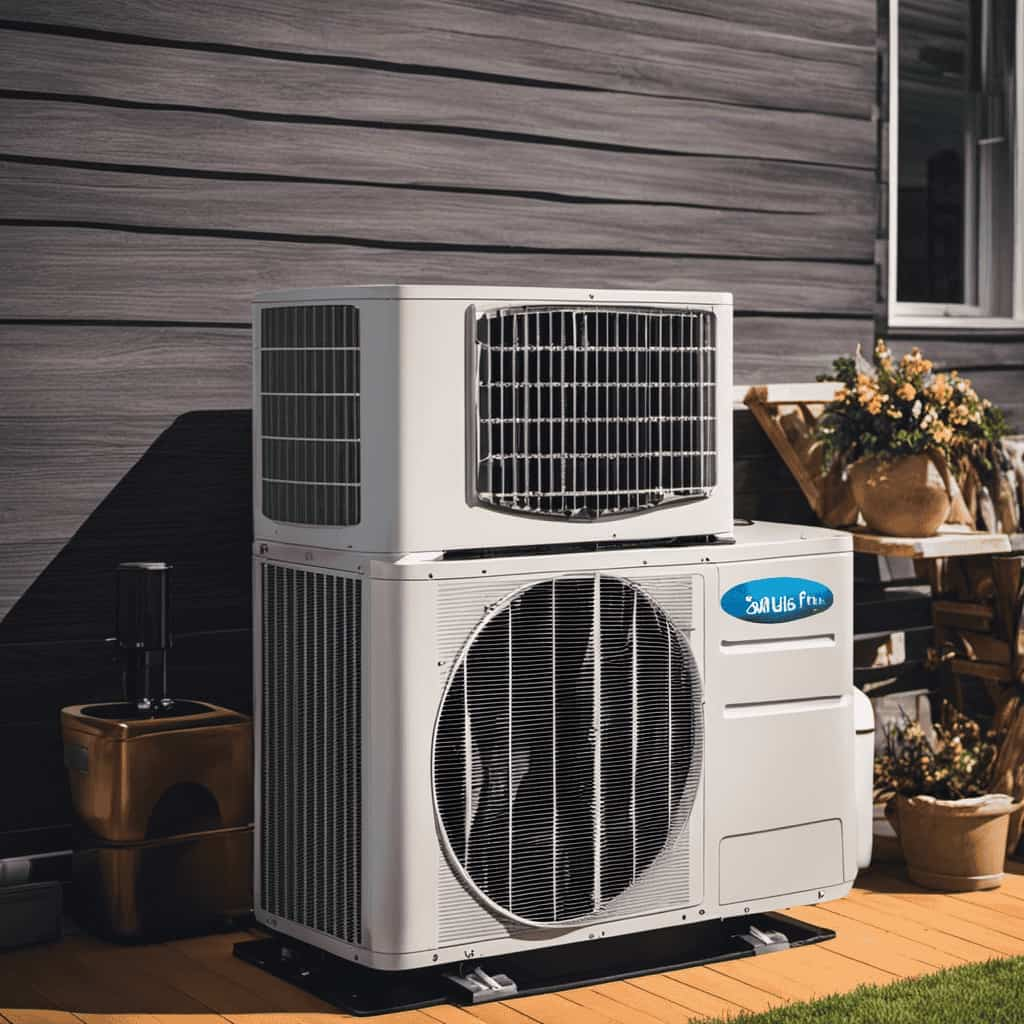
Improve Energy Efficiency
By regularly maintaining our heat pump refrigeration cycle, we can improve its energy efficiency and reduce our overall energy consumption. Proper maintenance ensures that all components are in optimal condition, allowing the heat pump to operate at its highest efficiency levels. This not only saves energy but also reduces our carbon footprint and lowers utility bills. Regular maintenance includes tasks such as cleaning or replacing air filters, inspecting and cleaning coils, checking refrigerant levels, and lubricating moving parts. In addition to these routine tasks, it is essential to schedule professional inspections and tune-ups to address any potential issues before they escalate. By investing in regular maintenance, we can prolong the lifespan of our heat pump, improve its performance, and ultimately save money by reducing energy consumption.
| Maintenance Task | Frequency | Benefits |
|---|---|---|
| Cleaning air filters | Monthly | Improves air quality |
| Inspecting coils | Annually | Enhances heat transfer |
| Checking refrigerant | Bi-annually | Optimizes cooling capacity |
| Lubricating parts | As needed | Prevents frictional wear |
Extend Lifespan of Pump
Maintaining our heat pump refrigeration cycle is crucial for extending the lifespan of the pump and ensuring its optimal performance. Regular maintenance not only helps to extend the lifespan of the pump but also improves efficiency, saving us both time and money.
Here are three key reasons why regular maintenance is important:
-
Preventive maintenance: By regularly inspecting and cleaning the heat pump, we can identify and address any potential issues before they become major problems, thereby extending the lifespan of the pump.
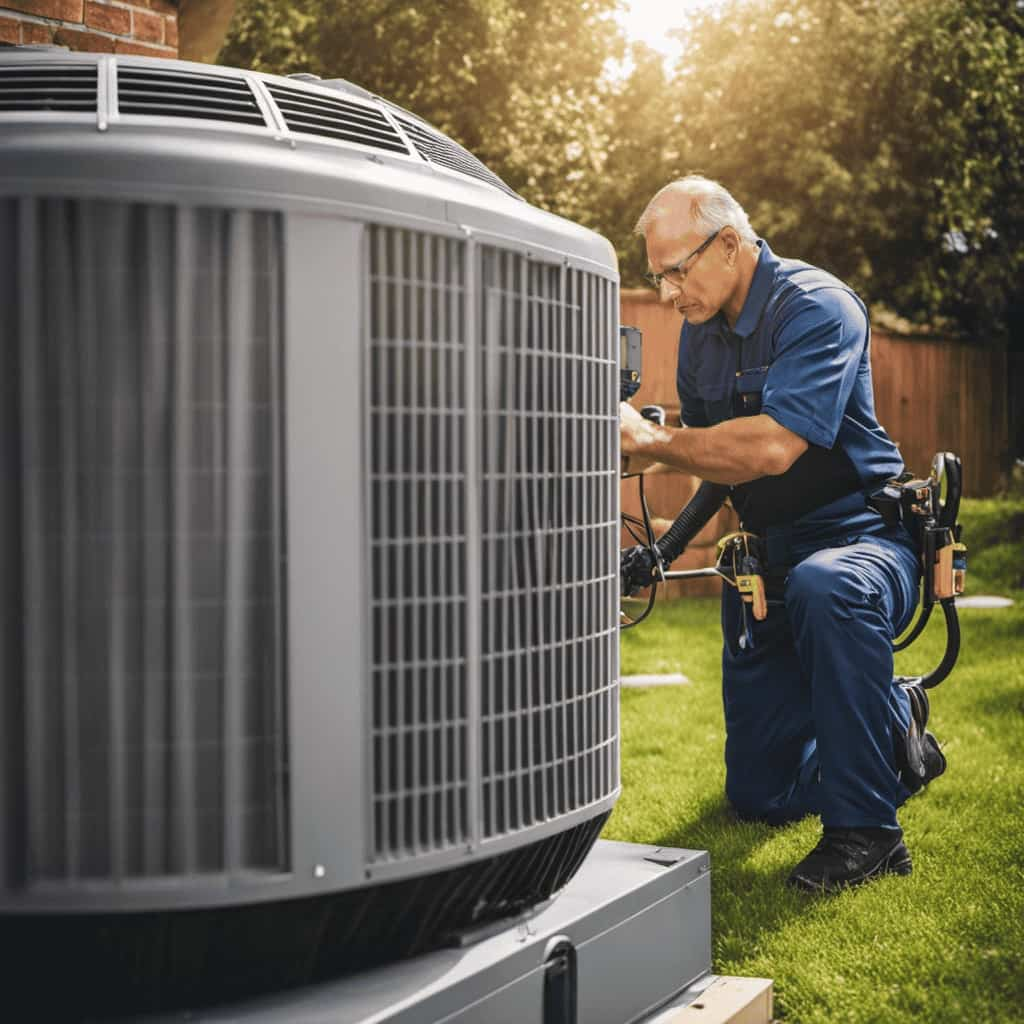
-
Efficiency optimization: Regular maintenance includes checking and cleaning the coils, filters, and fans, which improves the heat pump’s efficiency and reduces energy consumption.
-
Savings: With an extended lifespan and improved efficiency, the heat pump requires less energy to operate, leading to reduced energy bills and long-term cost savings.
Key Components of the Heat Pump Refrigeration Cycle
What are the key components of the heat pump refrigeration cycle? Understanding the refrigeration principles and troubleshooting refrigeration issues are essential for maintaining the efficiency and functionality of a heat pump. The heat pump refrigeration cycle involves several key components that work together to transfer heat from one place to another. These components include the compressor, condenser, expansion valve, and evaporator. The compressor plays a crucial role in pressurizing the refrigerant and moving it through the system. The condenser then releases heat from the refrigerant, causing it to change from a high-pressure gas to a high-pressure liquid. The expansion valve regulates the flow of refrigerant into the evaporator, where it absorbs heat from the surroundings, turning into a low-pressure gas. This cycle continues, providing efficient heating and cooling for your space.
| Component | Function |
|---|---|
| Compressor | Pressurizes the refrigerant and moves it through the system |
| Condenser | Releases heat from the refrigerant, causing it to change from a high-pressure gas to a high-pressure liquid |
| Expansion Valve | Regulates the flow of refrigerant into the evaporator |
| Evaporator | Absorbs heat from the surroundings, turning the refrigerant into a low-pressure gas |
Signs of Refrigerant Leaks in the Heat Pump Refrigeration Cycle
We can identify signs of refrigerant leaks in the heat pump refrigeration cycle through visual inspection and the presence of certain indicators such as hissing sounds or ice buildup on the evaporator coils. Detecting leaks early is essential to prevent further damage to the heat pump system.

Here are some key signs to look out for:
-
Hissing sounds: If you hear a hissing sound coming from the heat pump, it could indicate a refrigerant leak. This is caused by the pressurized refrigerant escaping from the system.
-
Ice buildup on evaporator coils: Another sign of a refrigerant leak is the formation of ice on the evaporator coils. This occurs when the refrigerant levels are low, causing the coils to become colder than they should be.
-
Reduced cooling or heating performance: A refrigerant leak can result in decreased efficiency of the heat pump, leading to inadequate cooling or heating.
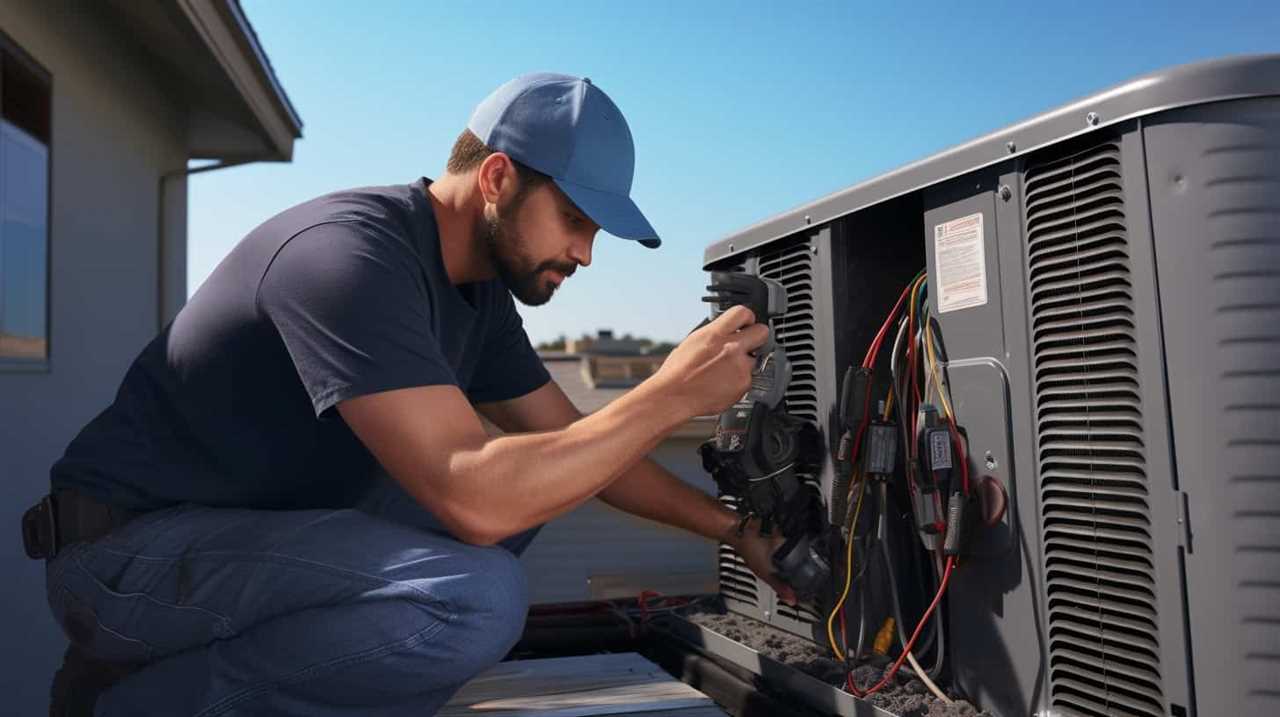
If you suspect a refrigerant leak, it’s important to have it repaired promptly to prevent further damage and ensure optimal performance of the heat pump system.
Steps to Check and Clean the Evaporator Coil in the Heat Pump Refrigeration Cycle
Let’s begin by understanding the steps to check and clean the evaporator coil in the heat pump refrigeration cycle.
The evaporator coil plays a crucial role in the cooling process by absorbing heat from the surrounding air. Over time, the coil can accumulate dirt, dust, and debris, which can hinder its performance and efficiency.
To clean the evaporator coil, start by turning off the power to the heat pump. Next, remove the access panel to gain access to the coil. Use a soft brush or a vacuum cleaner with a brush attachment to gently remove the dirt and debris from the coil. Be careful not to damage the delicate fins of the coil.

If the coil is heavily soiled, a coil cleaner can be used. After cleaning, inspect the coil for any signs of damage or leaks. If any issues are found, it’s recommended to contact a professional for further troubleshooting and repairs.
Tips for Proper Insulation of the Refrigeration Lines in the Heat Pump
For optimal performance and energy efficiency, we must ensure proper insulation of the refrigeration lines in the heat pump. Here are some key tips for proper installation and insulation techniques:
-
Choose the right insulation material: Use insulation materials with high thermal resistance, such as foam pipe insulation or rubber insulation, to minimize heat loss or gain.
-
Insulate all refrigeration lines: Insulate both the suction line and the liquid line to prevent condensation and maintain the desired temperature within the lines.

-
Seal all insulation joints: Ensure a tight and secure fit by sealing all joints with adhesive or tape to prevent air leakage.
By following these proper insulation techniques, you can improve the overall efficiency and performance of your heat pump system.
Now let’s move on to discussing common issues and troubleshooting tips for the heat pump refrigeration cycle.
Common Issues and Troubleshooting Tips for the Heat Pump Refrigeration Cycle
When encountering common issues with the heat pump refrigeration cycle, it’s important to troubleshoot them effectively to ensure optimal performance. By employing common troubleshooting techniques, you can identify and resolve these issues efficiently.

One common issue is inadequate cooling or heating. This can be caused by a malfunctioning compressor or low refrigerant levels. To troubleshoot this issue, check the compressor for any mechanical faults or electrical problems. Additionally, check the refrigerant levels and ensure they’re within the recommended range.
Another common issue is poor airflow. This can be caused by a dirty air filter or blocked vents. To troubleshoot this issue, clean or replace the air filter and ensure all vents are clear from obstructions.
How to Lubricate and Maintain the Compressor in the Heat Pump Refrigeration Cycle
When it comes to lubricating and maintaining the compressor in the heat pump refrigeration cycle, there are a few key techniques to keep in mind.
Firstly, it’s important to choose the correct lubricant that’s compatible with the compressor and the refrigerant used in the system.
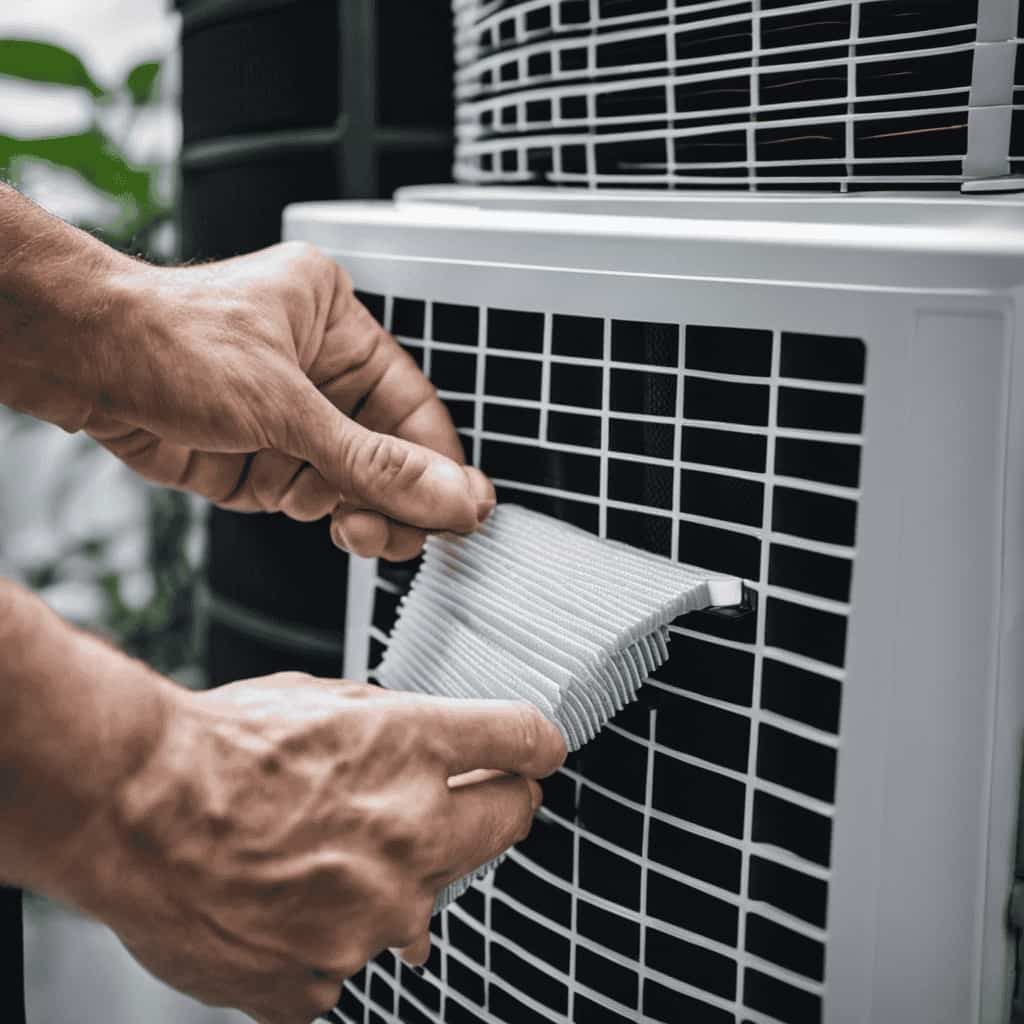
Secondly, regular lubrication should be performed according to the manufacturer’s recommendations to ensure proper functioning and prevent overheating of the compressor.
Compressor Lubrication Techniques
We regularly lubricate and maintain the compressor in the heat pump refrigeration cycle to ensure optimal performance. Proper compressor maintenance and lubrication techniques are crucial for the efficient operation of the heat pump. Here are some important points to keep in mind:
-
Choose the right lubricant: Select a high-quality lubricant that’s compatible with the specific compressor model and refrigerant used in the heat pump system.
-
Regular lubrication intervals: Follow the manufacturer’s recommendations for lubrication intervals. Typically, lubrication should be done every 500 to 1000 hours of operation.
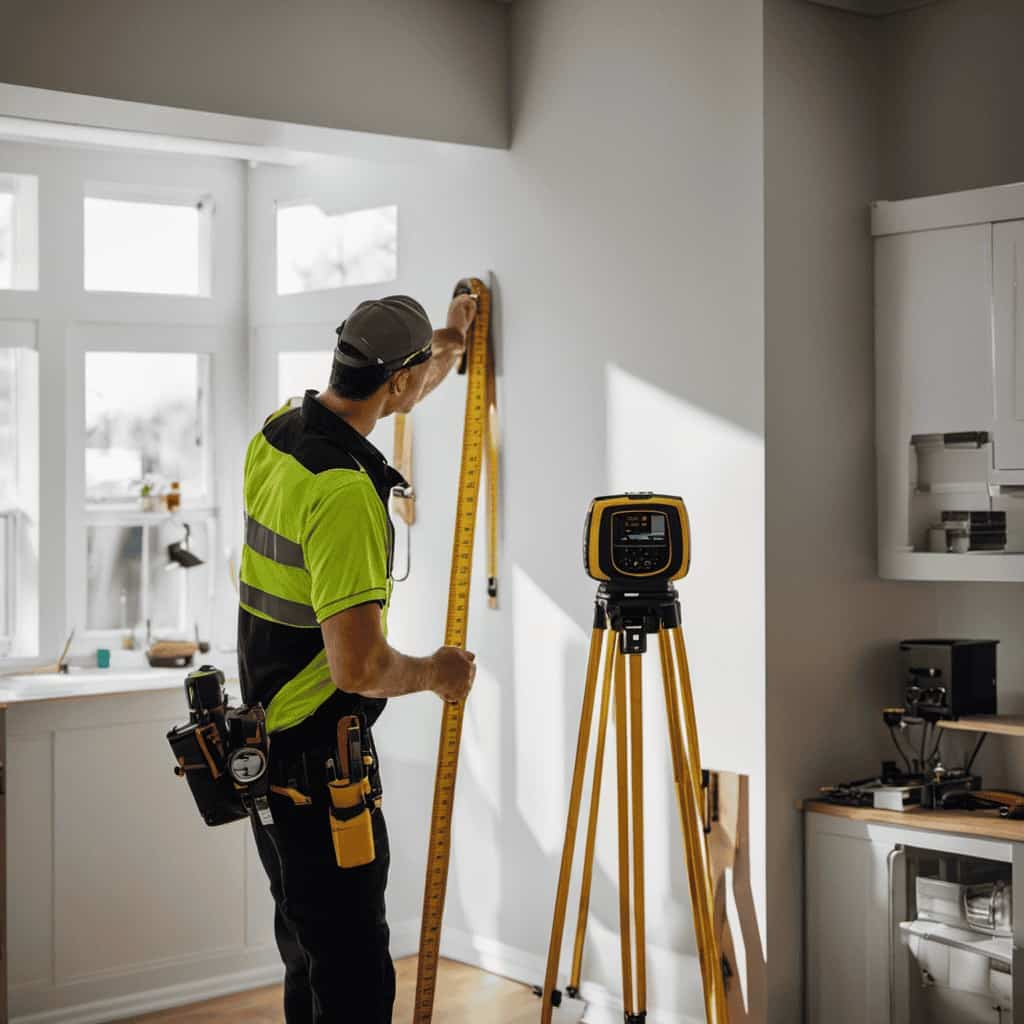
-
Proper lubricant application: Apply the lubricant to the compressor according to the manufacturer’s guidelines. Ensure that the lubricant is distributed evenly and covers all moving parts.
By following these compressor lubrication techniques, you can extend the lifespan of the compressor and maintain the efficiency of your heat pump system.
Regular maintenance and lubrication will help prevent costly breakdowns and ensure optimal performance for years to come.
Preventing Compressor Overheating
To prevent compressor overheating, we must ensure regular lubrication and maintenance of the compressor in the heat pump refrigeration cycle.

Proper lubrication is essential to reduce friction and wear between moving parts, preventing compressor damage and ensuring optimal performance.
It’s important to use the recommended lubricants specified by the manufacturer and follow the recommended lubrication schedule.
Regular maintenance also involves inspecting the compressor for any signs of wear or damage, such as leaks, unusual noises, or excessive vibration.
Troubleshooting compressor issues should be done promptly to prevent further damage. This may include checking the electrical connections, cleaning the coils, and ensuring proper airflow.

By prioritizing regular lubrication and maintenance, we can prevent compressor overheating and extend the lifespan of the heat pump refrigeration cycle.
Now, let’s move on to discussing how to prevent ice build-up in the heat pump refrigeration cycle.
How to Prevent Ice Build-up in the Heat Pump Refrigeration Cycle
In order to prevent ice build-up in the heat pump refrigeration cycle, we must regularly check and maintain the proper airflow and temperature settings. This is crucial for ensuring optimal performance and efficiency of the system.
Here are some key tips to help prevent ice build-up:

-
Regularly clean and replace air filters: Clogged or dirty filters can restrict airflow, leading to ice formation. Clean or replace filters every 1-3 months, depending on usage.
-
Inspect and clear the outdoor unit: Make sure the outdoor unit is free from debris such as leaves, grass, and dirt. This will help maintain proper airflow and prevent ice accumulation.
-
Implement defrosting methods: Utilize defrosting methods such as hot gas defrost or reverse cycle defrost to remove any ice build-up. This will help maintain the heat pump’s efficiency and prevent damage.
Importance of Proper Airflow in the Heat Pump Refrigeration Cycle
Proper airflow is crucial for the efficient cooling of a heat pump refrigeration cycle. It directly impacts energy consumption and overall performance.

Regular maintenance and attention to airflow are necessary to ensure optimal heat transfer and prevent any potential issues that can arise from restricted airflow.
Airflow for Efficient Cooling
The proper airflow is crucial for efficient cooling in the heat pump refrigeration cycle. To ensure optimal performance, it’s important to pay attention to improving ventilation and optimizing fan speed. Here are three key considerations:
-
Proper Duct Design: Ensuring that the ductwork is correctly sized and properly installed allows for efficient airflow distribution throughout the system. This reduces air resistance and minimizes energy loss.
-
Regular Filter Maintenance: Regularly cleaning or replacing air filters is essential for maintaining good airflow. Clogged filters restrict airflow, reducing the system’s cooling capacity and efficiency.

-
Fan Speed Adjustment: Optimizing the fan speed based on the cooling load can significantly improve system performance. Adjusting the fan speed to match the requirements of the space being cooled helps maintain consistent temperatures and reduces energy consumption.
Impact on Energy Consumption
Improper airflow can significantly impact energy consumption in the heat pump refrigeration cycle, so it’s crucial to ensure proper ventilation and fan speed optimization.
When the airflow is restricted or the fan speed isn’t optimized, the heat pump’s efficiency decreases, leading to increased energy consumption and higher energy bills. This not only affects the user’s pocket but also has a negative impact on energy savings and the environment.
By maintaining proper airflow, we can reduce the heat pump’s energy consumption, resulting in lower electricity usage and a reduced carbon footprint.

Proper ventilation ensures that the heat pump operates at its peak efficiency, maximizing energy savings and minimizing environmental impact.
Regular maintenance and cleaning of the heat pump’s air filters and coils are essential to ensure unrestricted airflow and optimal performance, contributing to energy savings and a greener future.
Maintenance for Optimal Performance
To ensure optimal performance, we must prioritize maintaining proper airflow in the heat pump refrigeration cycle. Proper airflow is crucial for improving performance and avoiding potential issues that can arise in the system. Here are some troubleshooting tips to help you maintain optimal airflow:
- Regularly clean or replace air filters to prevent clogs and ensure proper air circulation.
- Clear debris and obstructions from the outdoor unit, such as leaves, dirt, or vegetation, to allow for efficient heat exchange.
- Check and clean the indoor and outdoor coils to remove any build-up of dirt, dust, or debris that can hinder heat transfer.
By following these maintenance practices, you can ensure proper airflow in your heat pump refrigeration cycle, leading to improved performance and energy efficiency.

The Role of the Expansion Valve in the Heat Pump Refrigeration Cycle
We rely on the expansion valve to regulate the flow of refrigerant within the heat pump refrigeration cycle. The expansion valve plays a crucial role in maintaining the efficiency of the heat pump system. It’s responsible for controlling the amount of refrigerant that enters the evaporator coil, which is where the heat exchange process occurs. By restricting the flow of refrigerant, the expansion valve ensures that the evaporator coil operates at the optimal temperature and pressure. This allows for efficient heat transfer between the refrigerant and the surrounding air.
However, like any other component in the heat pump system, the expansion valve can experience issues that affect its performance. Troubleshooting expansion valve issues involves checking for refrigerant leaks, ensuring that the valve isn’t clogged or stuck, and verifying that the valve is properly sized for the heat pump system. Regular maintenance and inspection of the expansion valve are essential to prevent any efficiency losses or system malfunctions.
Frequently Asked Questions
Can a Heat Pump Refrigeration Cycle Be Used for Both Heating and Cooling Purposes?
Yes, a heat pump refrigeration cycle can be used for both heating and cooling purposes. It offers high efficiency, making it an advantageous option for heating and cooling systems.
How Often Should the Evaporator Coil Be Checked and Cleaned in a Heat Pump Refrigeration Cycle?
We should regularly check and clean the evaporator coil in a heat pump refrigeration cycle. It helps prevent common issues and ensures optimal performance. A statistic reveals that neglecting maintenance can reduce efficiency by up to 25%.

What Are the Common Issues That Can Occur in a Heat Pump Refrigeration Cycle and How Can They Be Troubleshooted?
Common issues in a heat pump refrigeration cycle include refrigerant leaks, compressor failures, and thermostat malfunctions. Troubleshooting tips involve checking for leaks, inspecting electrical connections, and calibrating the thermostat.
Is It Necessary to Lubricate and Maintain the Compressor in a Heat Pump Refrigeration Cycle, and if So, How Often Should It Be Done?
Yes, it is necessary to lubricate and maintain the compressor in a heat pump refrigeration cycle. The frequency of lubrication depends on the manufacturer’s recommendations, which can vary. Regular maintenance is crucial for optimal performance and longevity.
What Are the Potential Consequences of Ice Build-Up in a Heat Pump Refrigeration Cycle and How Can It Be Prevented?
Ice build-up in a heat pump refrigeration cycle can lead to reduced efficiency and decreased heating/cooling capacity. To prevent this, regular defrosting, proper insulation, and ventilation are necessary.
Conclusion
In conclusion, understanding and properly maintaining the refrigeration cycle in a heat pump is crucial for its optimal performance. Regular maintenance, such as checking for refrigerant leaks, cleaning the evaporator coil, and ensuring proper airflow, is essential.

By following these key tips, you can prevent issues like ice build-up and maintain the efficiency of your heat pump. Remember, a well-maintained heat pump will provide reliable and efficient heating and cooling for your home or business.
So, take care of your heat pump to enjoy its benefits for years to come.




